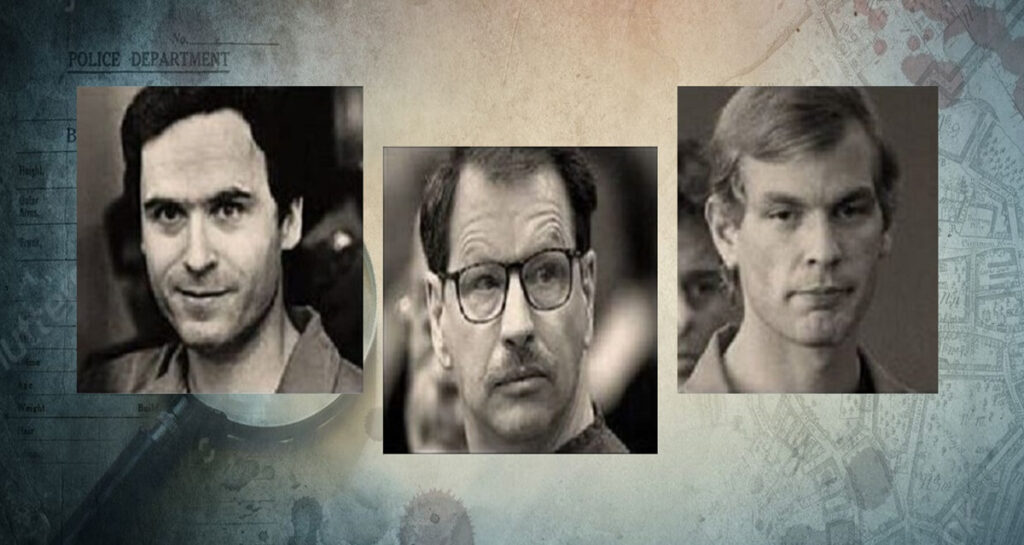The origins of psychology and the study of human behavior can be traced back to philosopher Rene Descartes. Back in the 17th century, he tried to answer the question of whether the body and mind were separate entities or intertwined with each other in some way. It was he who proposed that the human mind has influence over the physical body and equally the physical body can influence the mind.
The Criminal Profile: Criminal Psychology vs Forensic Psychology
Criminal psychology is the field of psychology that focuses on criminals and criminal behavior with the aim of understanding why criminals commit crimes. The role of a criminal psychologist extends to assessing offenders ascertaining the risk of reoffending, providing expert testimony in court, and offender profiling in developing a criminal profile.
The label of ‘criminal psychology‘ is often used interchangeably with forensic psychology and while there is some overlap there are also some clear differences between the two disciplines.
Forensic psychologists primarily provide their expertise within the criminal justice system where they apply their knowledge to criminal investigation and law.
While this can involve aspects of profiling and developing a criminal profile within an investigation, forensic psychologists spend most of their time in the judicial system and are not often directly involved in assisting law enforcement in solving a crime or hunting down a criminal.
Criminal Profiling
The idea of criminal profiling, or simply ‘profiling’ as it is often known, has been portrayed in the media through television, film and countless books. The hugely successful TV show ‘Criminal Minds‘ depicts a crack team of FBI Agents within the elite Behavioural Analysis Unit as they work together profiling serial killers and flying across America to help police forces track them down. Once they have assessed the crime scene and the evidence available, they deliver their criminal profile to the local law enforcement teams, ready to go out and find the killer.
The best-selling books “Whoever Fights Monsters” (1992) by Robert Ressler and Tom Shachtman and “Mind Hunter: Inside the FBI’s Elite Serial Crime Unit“ (1995) by John Douglas and Mark Olshaker, give us a glimpse of the real work of the FBI in their pursuit of understanding the minds of criminals and in the capture of some of America’s worst serial killers.
Related: Top 10 FBI Criminal Profiling Books
When combined, such material can give the general public a skewed view of what profiling actually is and the role of a criminal profiler. Furthermore, the terminology used to refer to a criminal profile can be varied.
Psychological profile, offender profiling, and criminal investigative analysis have all been used to describe the process and the criminal profile itself. Investigative psychology is an area developed to approach profiling based on science and as such is the preferred term for many people.

What is a Criminal Profile?
A criminal profile can be described as a behavioral profile of an offender generally created after the crime has been committed using evidence from the crime scene. As explained by Pete Klismet, a retired FBI criminal profiler:
“Criminal profiling is the art of developing a behavioural profile of an offender based on evidence from a crime scene and many other factors involved in an investigation of a violent crime.”
Understanding why a person has committed a crime can indicate their motive and if a motive is known, narrowing down the individual who carried out the crime becomes easier.
Related: FBI’s Robert Ressler: The Psychological Profiling of Serial Killers
Criminal profiling has made its name with the public in association with the hunt for serial killers and while used in this area, it is not its only use. Criminal profilers often work on cases such as bank robberies, arson, occult and ritualistic crimes, sexual assaults and rape cases, developing a criminal profile of each offender.

When it comes to serial killers, the assumption about an individual who could kill repeatedly and often in the most gruesome of manners is that they are insane to the point they are not in full control of their behavior, however, this is rarely the case.
Mental illness and violence are often associated together and can be a focus within media reporting, particularly when a murder is very brutal or is a random attack. However, statistically, the relationship between mental illness and violence is much lower than is often suggested.
There is a long list of serial killers who were declared entirely sane at their trials, meaning no mental health issue impacted their behavior and their reasoning for committing multiple murders. Jeffrey Dahmer, Ted Bundy, Dennis Nilsen, John Wayne Gacy, and Dennis Radar to name just a few.
The term ‘psychopath’ is often used, particularly when discussing serial killers and while some may fall into the category of a psychopathic killer, not all of them do. These are the kinds of issues that are taken into account when developing a criminal profile.
There are very few prosecuted serial killers who have been declared insane. Albert DeSalvo, the ‘Boston Strangler‘, is one serial killer who targeted women between 1962 and 1964 killing thirteen in total.
He was declared insane at trial and sent to a high-security mental hospital. He, however, escaped shortly afterwards and was then sent to a standard prison to complete his sentence.
Kenneth Erksine is another serial killer of note in terms of insanity. Known as the ‘Stockwell Strangler‘, he killed seven women in London in 1986 and was convicted and sentenced to 40 years in prison in 1988.
In 2009 he won an insanity appeal which ruled he should have been convicted of manslaughter on grounds of diminished responsibility. He is now detained indefinitely inside Broadmoor, previously known as Broadmoor Hospital for the Criminally Insane. A criminal profile is usually put together after a crime has been committed. We are not at the stage yet within psychology or neurocriminology to be able to predict when and if an individual will commit a crime and what type of crime that may be.
While individuals may show warning signs and may have aspects of their personality or behavior that are suggestive they are capable of committing such crimes, this is by no means a guarantee that they will go ahead and do so. Identifying who may or may not become a murderer, a school shooter or an individual who could take the lives of their own family is practically impossible and we are therefore left with trying to understand motives, drives, and behaviors after the fact.
There are however a number of behaviors which, to the trained eye, can provide valuable information about the personality of a killer.
For example, killers often follow the same modus operandi; that is how they carry out their crimes. A serial killer is often discovered due to the similar nature of each crime they are responsible for. A criminal profile is an attempt by an individual qualified in the study of human behavior to provide detailed information to law enforcement on the kind of individual who may have committed the crime in question. Not all crimes, however, are suitable for a criminal profile. A pattern of behaviors is most often required for an accurate and useful profile to be drawn up.

Inductive Verses Deductive Profiling
There have traditionally been two ways a criminal profiler can approach and develop a criminal profile of an offender. Inductive profiling uses historical information on crimes and known offenders to gain an understanding of these common traits and how they can be used. It is an approach that goes by the principle that if crimes committed by different people are similar, then the people who committed those crimes must also share common personality traits.
The key to this approach is similar crimes. A current crime can be compared to similar crimes of the past and the known perpetrators of those crimes. This can then provide information on the characteristics, personality types and behaviors most likely that will be found in the perpetrator of the crime at hand, helping to narrow down a list of suspects or highlight the types of personality more likely to have committed the crime.
The deductive method of criminal profiling, in contrast, is more similar to what is highlighted in the media and on television. The information about the criminal in question comes directly from an analysis of the crime scene.
Victimology is also very important where the profiler finds out all information they can about the victims of the crime. The idea is that the more information is known about the victim the more information can be gained about the offender.
While inductive profiles can be fairly quick to develop, a profiler using the deductive method could take many weeks or months to build a full criminal profile. The crime scene is vital in this approach and it must be left untouched if its full potential for providing information can be tapped into. If a crime scene has been cleaned up or altered either by the family or the police officers on the scene, this can be very damaging to this type of criminal profile.
Of course, a criminal profiler will often use a combination of these approaches in developing a criminal profile. The historical information about similar crimes should never be ignored and can provide valuable information when taken into account in conjunction with the current crime scene and victimology information. Equally, a knowledge of psychology and psychiatry through criminal psychology gives an understanding of human behavior. When added to historical crime information on similar types of crime and the current crime scene information, a profiler can build a full picture.
Related: Inside The Mind of a Psychopath – The Psychopathic Killer
The crime scene can be the most important factor in beginning to understand the pathology of a criminal, particularly in a murder case. Some crimes are planned, carefully thought out, and executed in accordance with that plan. They show the organization and thought behind the series of events. Other crimes are not so organized, they can be chaotic, more opportunistic and do not display the same level of thinking beforehand to ensure some control over the events.

Organized and Disorganized Behaviors
A key feature in the literature on criminal profiling is the organized versus disorganized killer, and this can be deduced mainly from the scene of their crime. Such categories reflect the killers’ personalities which can provide clues into how they think and operate and who they might be.
- Organized killers tend to leave little evidence at a crime scene, they are antisocial personalities but they do understand what is right and what is wrong and are entirely sane individuals. They plan, pick their victim in advance, and bring any tools or aids with them to their selected location for the attack.
- Disorganized killers, in contrast, tend to leave more evidence at the scene of the crime that can be traced, such as fingerprints or bodily fluids. They can act more impulsively than organized offenders which is often the reason for their disorganized presentation at a crime scene. Often these types of killers have a mental illness or could be under the influence of substances at the time of the crime. However, they should not all be assumed to be mentally ill, many disorganized offenders are highly intelligent and by no means insane. They can integrate with society and do not stand out as a person who may have sinister intentions toward others.
Criminal Profiling as a Science
Many have argued that criminal profiling does not have enough scientific evidence to support its existence and should not be relied upon or used as frequently as it is. They highlight the methods used to have no solid theoretical grounding or evidence for their use.
It is, therefore, not universally accepted that criminal profiling is a science and many fear it is a phantom science, a creation carried through information passed between the literature, police officers, and mental health professionals that have given the illusion that it is an area with supporting evidence.
Moreover, there has been some criticism of the early FBI unit profilers, such as Robert Ressler and John Douglas, for not being trained and qualified psychologists. However, it cannot be denied that the work they carried out has been hugely influential in the development of the field.
The openness and acceptance of a police department towards a criminal profile are important in the process. If the police have no faith in a criminal profile or its uses, it is unlikely to be included in the investigative process.
The notion of criminal profiling being ‘mumbo-jumbo’ and on the same level as many people’s views on psychics have diminished significantly from the early years of profiling, however, there are still many individuals who believe it is simply common sense and of no real value.
Criminal profiles are common sense but they are common sense from the point of view of personalities and resulting behaviors to an individual trained in this area of human behavior. Without the knowledge and understanding of behaviors in different people, such information may not be something that can be deduced by other individuals working on a criminal case.
Related: Can Criminal Behavior Be Predicted Using Brain Scans?
The Purpose and Uses of a Criminal Profile
The purpose of a criminal profile is to help a police investigation narrow down the search for the perpetrator of a crime. A profile that can provide an age range, type of employment, marital status, and education and behavioral information can be of great benefit to police in their hunt, ensuring their investigative efforts are focused in the right area. If all investigators are aware of this profile they can be alert to potential suspects and possible links which all could aid the investigation.

A criminal profile however can go further than simply narrow down a field of suspects due to age and employment status. An understanding of the psychology of an offender can also bring insights into how they may have behaved at the crime scene. For example, whether they have taken items from the scene or from the victim directly, why they may have done this, and what they may have done with them.
Often such items are taken as a reminder for the offender of that particular crime, commonly referred to as ‘souvenirs‘, and therefore they will be found somewhere accessible to them. If an offender has been arrested and such items are found, the exact items, where they were found and what the offender had done with them can provide more information to a profiler about the psychology of this offender. This is information that can be passed onto interviewing officers which can be used in trying to get the offender to open up about their crimes.
The value of profilers to interviewing officers can be great. An understanding of psychology, how different individuals may think about things, view their crimes or their victims, and their attitudes, responses, and behaviors can be of great benefit when trying to get an offender to open up.
Effective interviewing techniques are very important and could save many many hours in interviewing a suspect. Using psychology in such a way, different strategies for obtaining information for different offenders can be applied. A technique effective for one individual may be ineffective for another and a profiler can explain why that is and which route to go for.
James Brussel and the ‘Mad Bomber’ of New York
One of the early and most famous cases of a criminal profile assisting in the solving of a crime was the ‘Mad Bomber’ of New York City between 1940 and 1956. Over 30 small bombs had been placed in various locations in the city, many in public areas, and police were struggling to identify the bomber who by this time had been reigning terror in New York for 16 years. Remarkably, no one had been killed in the bomb blasts but many were injured and there was fear the next bomb would kill.
In 1956, James Brussel, a psychiatrist in New York, was asked to study the crime scene photos and investigation notes in case he could provide any assistance as to the type of individual they were looking for. What he came up with came as a surprise to most. A detailed criminal profile stated the ‘bomber’ would be in his 50s, he would be foreign and unmarried and he would live in Connecticut. He would be very neat in his appearance and have a particular personality liking everything in its place.
Curiously, Brussel stated when he was caught he would be wearing a double-breasted jacket which would have the buttons neatly done up. Furthermore, this was a male who had a grudge against the power company where the first bomb was left, Con Edison. He was most probably a former employee who may have been injured on the job and is looking for revenge on the company that he blames.
Most of this profile while sounding exact, is information that can be deduced from the nature of his crimes. For example, the majority of bombers are male and the first target along with letters sent to the police declaring Con Edison would be brought to justice and they will “pay for their dastardly deeds” clearly suggest the company themselves are the source of the bomber’s anger.
Upon searching the employee records at Con Edison, one name stood out that matched the Brussels profile. George Metesky had indeed been injured at work and had not received the compensation he believed he deserved. Furthermore, in a series of letters to the company, after his disability claim was denied, he referred to their “dastardly deeds”.
George Metesky was arrested and confessed to planting the bombs. At the time of his arrest, he was indeed wearing a buttoned-up double-breasted jacket. He matched Brussel’s profile exactly. Criminal profiles are tools to help investigating officers solve crimes. By themselves, they cannot solve a crime, but what they can do is assist and focus police investigations in the right direction.
They are the application of psychological knowledge about the personalities, actions, behaviors, drives, and motivations within criminal psychology to build a picture of the traits of the individual who may have carried out the crime in question. While the scientific basis of criminal profiling is still in question and profiles are not always right, their usefulness within criminal investigations cannot be denied.
- All-about-forensic-psychology.com, (2015). Interested in criminal profiling? Retrieved 28 August 2015.
- Personal.psu.edu, (2015). Brief History of Psychology. Retrieved 28 August 2015.
- Profilesofmurder.com, (2013). Profiling | Profiles of Murder. Retrieved 28 August 2015.
- Winderman, L (2004) Criminal Profiling; the reality behind the myth. American Psychological Association, Vol 35, No. 7, pp66
Guy, F. (2015, Sept 02) The Criminal Profile in Crime Psychology. Crime Traveller. Retrieved from https://www.crimetraveller.org/2015/09/criminal-profile/




How did he know the bomber would be wearing a buttoned up double breasted jacket? That is quite remarkable! I find it fascinating that murderers leave behind clues to who they are through how they have killed and how they have left the crime scene. Instead of just forensics, we can now gain information through psychology and what is known about behaviours and patterns. I bet serial killers have no idea how much information and clues they leave behind.
Hi Valerie, it is surprising he was able to make such an accurate prediction, I agree! I assume as he had concluded the man in question was going to be very particular in his personality and appearance and the era at the time it was an educated guess that paid off.
Criminal profiling is fascinating and the understanding we now have of different personalities and their behaviour is growing all the time. It makes sense to apply this knowledge to crime and where there are patterns of behaviour, as there generally is with serial killers, it can really provide some useful insights. Thanks for stopping by!
Hey there, thanks for all this info… been looking for this for some time now, thanks alot